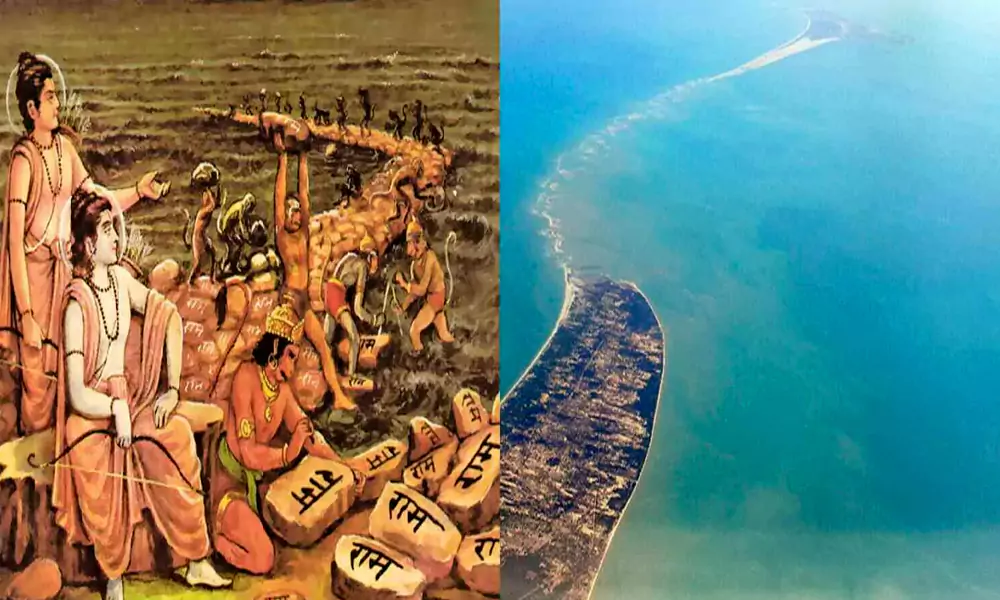Ram Setu is one of the ancient human-made structures on Earth that stands from immemorial. It starts in India and extends to Sri Lanka. This causeway, also known as “The Adams Bridge”, connects faith with science. The stones on the bridge remind us that they hold the truth about the bridge as many wonder how Lord Ram could build a bridge using floating stones!
Palk Straight or Ram Sethu is a collection of limestone shoals from Pamban in Tamilnadu to Mannar Island in Sri Lanka. As the legends say, Lord Ram constructed Adam’s bridge with his Vanar Sena on the ocean. The carbon analysis surprisingly shows the time 5000 BCE as the date of construction. To date, the debate about whether the causeway is artificial or natural continues, and it intrigues the brain of humans to dig deep into this topic.
Textual reference of Ram Setu or Adams Bridge:
IBN Kordabeh mentioned Ram Setu as Set Bhandai or “bridge of the sea” in his “Book of Roads and Kingdoms” in 850 BC. Al Beruni- an Iranian scholar, described the story of Adam living on Adam’s peak, leaving a big footprint around 1030 CE in his book Tarikh-Al-Hind.
Interesting Spiritual and scientific facts about Ram Setu:
- Why is this bridge called Adam’s Bridge? The name reminds us of the ancient Islamic legend when Adam got expelled from Aden’s garden after eating the forbidden fruit. He travelled to India from Sri Lanka through this bridge. Iranian scholar Al Berini says that Adam spent 1000 years at Adam’s Peak and stood on one foot with his heart filled with grief. Abrahamic myth calls this causeway Adam’s bridge. The followers of Abrahamic religions consider this bridge to bear the footprints of Adam after he fell on Earth from heaven.
- Mythological story Ramayana mentions RamSetu: The earliest mention of Ram Setu is in Valmiki’s Ramayana. He says that Lord Ram, with his brother Lakshman, set out on an expedition to find out about his lost wife- Sita. When he reached the end of Bharat Bhumi, he desperately needed to find a way to reach Srilanka to fetch his wife back. Lord Ram prayed to Samudradev to show a way across the Indian Ocean. Samudradev told Lord Rama that Nila and Nala- twin brothers, could build a bridge with floating stones. All the stones in the setu have Lord Ram’s name on them.
- Is this bridge walkable? Ramanatha Swamy temple records say that until 1480, people could walk across Ram Sethu when a cyclone destroyed the structure, leaving it unusable. The storms across the ocean deepened the channel, making it invisible and dangerous to access.
- Is Nala’s Setu a natural structure? Nala’s Setu is a chain of natural limestone shoals that extends from Pamban Island in Tamilnadu to Mannar Island in Sri Lanka.
- Floating stones are still a mystery: One of the questions that perplexed the human mind is how floating stones from Ramsethu could make a bridge. The stones are pumice stones formed from a volcanic eruption that floats in water. They are hardened forms of lava filled with air bubbles that make them light to keep afloat. The findings of Lawrence Berkeley National Laboratory suggest that the air inside the stones will escape. The stones will start submerging in the water. The sand bar in this area is only 4000 years old, whereas the pumice stones used to make the bridge are 7000 years old. The Vanar Sena might have brought these stones from somewhere else to complete the bridge constriction.
- No ship zone: The pumice stones are almost above sea level. But this water is not navigable because the water in this area is very shallow. While sailing from India to Sri Lanka, the ships take a different route as the sea in this area in Ram Sethu is of varying depths.
- NASA Images: The submerged floating pumice stones that made the bridge once are visible in NASA images. Surprisingly, these stones can be seen thousands of kilometres from the Earth.
- Carbon analysis syncs with the Ramayana period: Despite the argument that the stones that make up the bridge are natural, carbon analysis shows otherwise. It syncs perfectly with the Ramayana period. The carbon analysis proves that the Vanar Sena headed by Hanuman constructed Ram Sethu for Lord Rama.
- Setu Samudragupta shipping project: The RamSethu project is a joint program by the Governments of India and Sri Lanka. It would connect the Palk straight and the Gulf of Mannar. The proposed artificial causeway would be the shortest route from Sri Lanka to India and require low maintenance. It is surprising to note that the British engineer A.D Taylor proposed the project in 1860, which the Indian government accepted during the year 2005. SetuSamudram project formed part of election manifestos many times without any development.
- Wide uproar against the project: The plan is to construct the structure on limestone shoals, which led to a widespread uproar in India for the Ram Sethu project. It deeply hurt the religious sentiments of Hindus. It would also necessitate the burrowing 44.9 nautical miles deep water channel. The act would create a negative impact on the environment, and would permanently damage the shoals in Ram Sethu. As a result, the government made a recent plan considering five alternative routes to avoid damage to the limestone shoals.
The political background of the Setu Samudram project:
Major James Rennel- a British geographer, suggested the construction of a navigable passage along the Ram Sethu. It would serve as an easy trade route between these two countries. However, trade between India and Sri Lanka was active from 1 millennium BCE.
His voice was unheard until the proposal to deepen the Straight started in 1838. Still, it was unusable as the water was shallow even after dredging the channel. Later, in 1860, Commander A.D. Taylor revived the idea of constructing a structure. However, the government dropped the idea, and there was no progress in building a pathway between these two countries.
In 1955, Dr A Ramaswamy Mudaliar headed the Sethu Samudram project committee to check whether the proposed project was feasible economically and ecologically. It recommended making an overland passage instead of damaging the Palk Straight. In 2008, Dr Manmohan Singh formed a six-member committee to proceed with the project. In 2014, the Modi government confirmed the plan of completing the project. It remains incomplete, though.
Conclusion:
Ram Setu is a 48 km long bridge that connects Sri Lanka and India. It has a mysterious story about its origin. Some believe that it is a natural pass formed out of limestone shoals. Some others believe Lord Ram and his Vanar Sena built it to bring back his lost wife- Sita to Ayodhya. It was passable till the 15th century when a cyclone permanently destroyed it.
FAQs:
NO. The archaeological survey of India found no constructive proof to support the theory that Lord Ram constructed Ram Sethu.
Yes. Ramanatha Swamy temple records prove that the entire bridge was passable till 1480. Even now, tourists can walk through the bridge for some distance even though they can’t travel the whole 48 km to reach the Gulf of Mannar.
The bridge is made of pumice stones that are air-filled inside them. Until the air escapes the stones they will remain floating in water.





Leave a Comment :